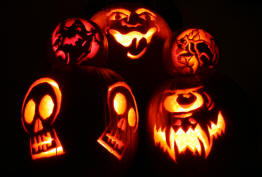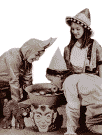|
 The origins
of Halloween
is said to date back more than 2,000 years to the Celtic festival of
Samhain.
The Celts roamed over what is now the United Kingdom, Ireland and
northern France. The origins
of Halloween
is said to date back more than 2,000 years to the Celtic festival of
Samhain.
The Celts roamed over what is now the United Kingdom, Ireland and
northern France.
Their new year began Nov. 1, starting
with a festival the previous night honoring Samhain to mark the
beginning of the season of cold & darkness (beginning of winter), and
human mortality. The Celts believed that Samhain allowed the souls of
the dead to return to their earthly homes on this night.
 In addition to making themselves visible to humans, these spirits also
played tricks on people. In addition to making themselves visible to humans, these spirits also
played tricks on people.
To commemorate Samhain, Druids - high priests and teachers of the Celts,
ordered the
people to put out their hearth fires and build a huge new year's bonfire
of oak branches, which were considered sacred. The
Druids burned animals, crops and - according to some historians - human
beings as sacrifices to Samhain. Each family then relit its hearth fires
from the new year's bonfire.
 During the celebration, the Celts wore costumes, typically consisting of
animal heads and skins, and attempted to tell each other's fortunes by
examining the remains of the animals that had been sacrificed for signs
that would foretell the fortunes of the coming year. When the
celebration was over, they re-lit their hearth fires, which they had
extinguished earlier that evening, from the sacred bonfire to help
protect them during the coming winter. During the celebration, the Celts wore costumes, typically consisting of
animal heads and skins, and attempted to tell each other's fortunes by
examining the remains of the animals that had been sacrificed for signs
that would foretell the fortunes of the coming year. When the
celebration was over, they re-lit their hearth fires, which they had
extinguished earlier that evening, from the sacred bonfire to help
protect them during the coming winter.
By A.D. 43, Romans had conquered the majority of Celtic territory. In
the course of the four hundred years that they ruled the Celtic lands,
two autumn festivals of Roman origin were combined with the
traditional Celtic celebration of Samhain.
 The first was Feralia, a day in late October when the Romans
traditionally commemorated the passing of the dead. The second was a
harvest festival named after Pomona, the Roman goddess of fruit
and trees. The symbol of Pomona is the apple and the
incorporation of this celebration into Samhain probably explains the
tradition of "bobbing" for apples that is practiced today on
Halloween. The first was Feralia, a day in late October when the Romans
traditionally commemorated the passing of the dead. The second was a
harvest festival named after Pomona, the Roman goddess of fruit
and trees. The symbol of Pomona is the apple and the
incorporation of this celebration into Samhain probably explains the
tradition of "bobbing" for apples that is practiced today on
Halloween.
By the 800s, the influence of
Christianity had spread into Celtic lands. In the seventh century, Pope
Boniface IV designated November 1 All Saints' Day, a time to honor
saints and martyrs. It is widely believed today that the pope was
attempting to replace the Celtic festival of the dead with a related,
but church-sanctioned holiday. The celebration was also called
All-hallows or All-hallowmas (from Middle English Alholowmesse
meaning All Saints' Day) and the night before it, the night of Samhain,
began to be called All-hallows Eve and, eventually, Halloween.
Even later, in A.D. 1000, the church
would make November 2 All Souls' Day, a day to honor the dead. It was
celebrated similarly to Samhain, with big bonfires, parades, and
dressing up in costumes as saints, angels, and devils. Together, the
three celebrations, the eve of All Saints', All Saints', and All Souls',
were called Hallowmas.
HALLOWEEN: Coming To America...
Samhain
^ back to top
Source:
The History Channel,
Detroit News
|

